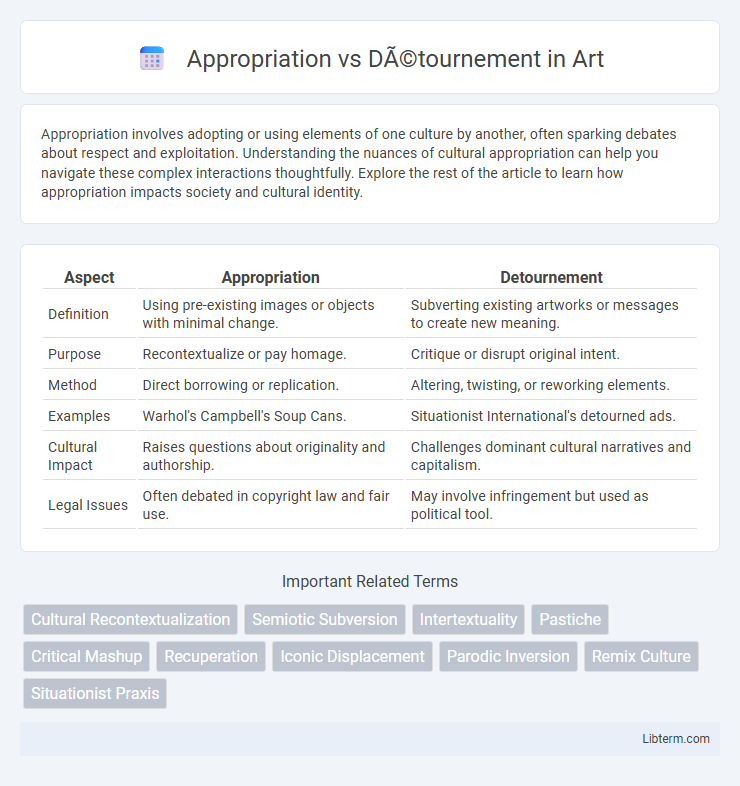Appropriation involves adopting or using elements of one culture by another, often sparking debates about respect and exploitation. Understanding the nuances of cultural appropriation can help you navigate these complex interactions thoughtfully. Explore the rest of the article to learn how appropriation impacts society and cultural identity.
Table of Comparison
| Aspect | Appropriation | Detournement |
|---|---|---|
| Definition | Using pre-existing images or objects with minimal change. | Subverting existing artworks or messages to create new meaning. |
| Purpose | Recontextualize or pay homage. | Critique or disrupt original intent. |
| Method | Direct borrowing or replication. | Altering, twisting, or reworking elements. |
| Examples | Warhol's Campbell's Soup Cans. | Situationist International's detourned ads. |
| Cultural Impact | Raises questions about originality and authorship. | Challenges dominant cultural narratives and capitalism. |
| Legal Issues | Often debated in copyright law and fair use. | May involve infringement but used as political tool. |
Understanding Appropriation and Détournement
Appropriation involves the intentional borrowing or reuse of existing cultural elements to create new artistic meanings, emphasizing transformation and context shift. Detournement specifically alters or subverts pre-existing media to critique or undermine its original message, often linked to Situationist practices. Understanding these concepts reveals how artists challenge authorship and cultural norms by recontextualizing familiar imagery or texts.
Historical Origins and Evolution
Appropriation and detournement originate from distinct historical contexts, with appropriation rooted in early 20th-century art movements like Dadaism and Surrealism, where artists repurposed existing imagery to challenge traditional aesthetics. Detournement emerged from the Situationist International in the 1950s and 1960s, emphasizing the radical subversion of dominant cultural symbols to critique capitalist society. Both techniques evolved through decades of artistic and political activism, influencing contemporary practices in visual art, media, and cultural theory.
Defining Key Concepts and Differences
Appropriation involves taking existing images or objects to give them new meaning or context, often without altering their original form, whereas detournement actively subverts and transforms these elements to critique or undermine their original purpose. Appropriation typically aims to recontextualize cultural artifacts, while detournement, rooted in Situationist theory, uses modification to disrupt dominant ideologies and provoke critical awareness. The key difference lies in appropriation's emphasis on reuse versus detournement's focus on radical alteration and political intervention.
Major Theories and Influences
Appropriation and detournement are key concepts in cultural theory, with appropriation involving the adoption of elements from one culture or context by another, often debated in postmodernism and critical theory. Detournement, originating from the Situationist International, emphasizes subverting and recontextualizing existing media or cultural artifacts to challenge dominant ideologies. Major influences include theorists like Guy Debord for detournement and Walter Benjamin for appropriation, whose work on mechanical reproduction and aura informs contemporary debates on originality and authorship.
Appropriation in Contemporary Art
Appropriation in contemporary art involves the intentional borrowing, copying, or recontextualizing of existing images, objects, or styles to create new meaning and challenge traditional notions of originality. Artists like Sherrie Levine and Richard Prince exemplify this practice by repurposing iconic works to critique authorship and cultural ownership. This method disrupts conventional art narratives by questioning the boundaries between originality and imitation, thus engaging audiences in critical dialogue about intellectual property and cultural consumption.
Détournement in Political and Artistic Contexts
Detournement, a tactic pioneered by the Situationist International, involves the subversion and recontextualization of existing images, symbols, or media to create new, politically charged meanings that challenge authoritarian or capitalist narratives. In artistic contexts, detournement transforms familiar cultural artifacts into critical commentaries, disrupting dominant ideologies through irony and satire. Politically, it functions as a form of resistance by exposing and undermining propaganda, thereby empowering marginalized voices and fostering radical social critique.
Legal and Ethical Considerations
Appropriation involves the use of existing cultural or artistic elements, often raising legal issues related to copyright infringement and intellectual property rights, while detournement recontextualizes these elements to subvert and critique original meanings, challenging traditional notions of ownership and originality. Ethically, appropriation may be criticized for exploitation or cultural insensitivity, whereas detournement is typically defended as a form of political or social commentary that promotes critical thinking. Navigating the legal frameworks requires balancing respect for creators' rights with protections for freedom of expression and transformative use.
Cultural Impact and Reception
Appropriation in art often involves the borrowing of cultural symbols, leading to debates on authenticity and potential cultural insensitivity, whereas detournement actively subverts existing cultural elements to challenge dominant ideologies and provoke critical reflection. Appropriation can sometimes perpetuate stereotypes or reinforce power imbalances, while detournement tends to foster critical engagement and social commentary by altering context and meaning. Reception of appropriation varies widely, from accusations of exploitative mimicry to appreciation of cross-cultural dialogue, whereas detournement frequently garners attention for its radical critique and transformative impact on cultural narratives.
Case Studies: Notable Examples
Appropriation and detournement are pivotal concepts in art and media studies, exemplified by notable case studies such as Marcel Duchamp's "Fountain," which redefined appropriation by transforming a urinal into a work of art, challenging traditional authorship and originality. In contrast, the Situationist International's use of detournement, notably in Guy Debord's reinterpretation of capitalist advertising imagery, subverts existing cultural symbols to critique mass consumerism and dominant ideologies. These case studies highlight the transformative power of recontextualization in challenging social norms and artistic conventions.
Future Trends and Emerging Practices
Appropriation and detournement continue to evolve as key practices in contemporary art, with future trends emphasizing the integration of digital technologies such as augmented reality and blockchain to challenge authorship and originality. Emerging practices explore AI-generated content to redefine cultural references, fostering participatory and decentralized creative experiences. These shifts highlight increasing dialogue around intellectual property, cultural identity, and the socio-political impact of recontextualized imagery in the digital era.
Appropriation Infographic

 libterm.com
libterm.com